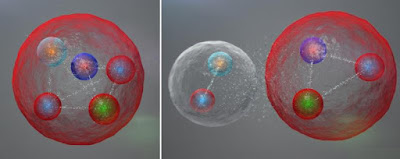Murray Gell-Mann in 1964, described how the protons and neutrons that make up atomic nuclei are themselves composed of three quarks and how other particles known as mesons are made from pairs of quarks and their antimatter counterparts, antiquarks. Gell-Mann's scheme also pointed to the existence of pentaquarks, made up of four quarks and an antiquark. The LHCb collaboration at CERN has now found experimental evidence for the pentaquark's existence.
This illustration by Daniel Dominguez shows the possible layout of the quarks in a pentaquark particle. The five quarks might be tightly bound (left). They might also be assembled into a meson (one quark and one antiquark) and a baryon (three quarks), weakly bound together—a bit like two atoms combining to form a molecule:
The "charmonium" pentaquark contains two up quarks, one down quark, one charm quark, and one anticharm quark.
Links: paper (724 authors) | press release





No comments:
Post a Comment